Manage a Mapathon
Criado em 2017-01-30
Introdução
What type of event
Deciding on what type of event you want to host will decide the direction you need to go and the steps you need to take.
This guide deals with indoor Mapathons for larger groups.
For other types of gatherings for mapping see
Weekend Mapping Projects
Mapping Parties
A Mapathon is an organised gathering of people to add data to the OpenStreetMap. This can be a project to improve the map in your local area, or to help Response Teams on the ground during a Disaster, or a Missing Maps Project for ongoing or future Humanitarian Responses.
Your Mapathon can be open to training new mappers as well as a regular event for experienced mappers and could consist of a training session, mapping time and time to socialise.
While we can give general guidelines on how to organise a Mapathon, your event will evolve and develop its own structure and identity depending on the people who organise it, the venues available and the people that turn up to map.

History of a successful Mapathon
The London Missing Maps Mapathons started back in 2014 as a small group training new mappers. They had the advantage of being able to involve many large corporate sponsors with great venues with capacities of around 80+ mappers.
It started off with training all of the attendees in basic mapping using iD as the editor of choice for beginners.
The event was held once a month and mappers could book a free place through Eventbrite. After a while it was noted how many attendees were returning for more mapping and training. The decision was made to split the event into training newcomers on iD, to migrate the returning mappers onto JOSM and validator training was also introduced. This format has proved very successful but the result is having to turn mappers away because the event is full. A second Mapathon was started up, the Mid Month Mapathon for the more experienced JOSM users that would concentrate on the more advanced mapping and investigate and test new ideas.
The success of the London event is based on a number of factors but mainly the following strategy…
- Experience taught us that the learning curve for people with no mapping experience whatsoever is very steep and can be off putting and frustrating for these newcomers if they cannot get some mapping done on their first event. It is important to get them mapping as quickly as possible, so they were shown just the very basics with the simpler iD editor, letting them encounter their own particular problems during the course of the evening when they were able to ask for help.
- It was much easier teaching mappers the more complex JOSM editor if they already had experience of mapping with the iD editor or some other GIS programme. It also meant that you were dealing with a group that were interested in advancing their mapping skills rather than just along to find out what it was about and whether they liked it or not.
- It was a regular event on the first Tuesday of each month so they could take it into account in advance and keep that slot open when arranging their lives.
A second event (Mid Month) and validator training at the monthly event gives the more experienced mappers a chance to tackle more advanced and interesting projects such as validating, experimental techniques and Field Papers.
Start working on your Mapathon at least a month before for organising and preparing the event.
The size of the available venues and the availability of facilities at the venue will decide the factors for your Mapathon. A venue can be a local company, university or school, arts centre, library, hall. The points to note:
- Is the venue centrally situated and easy to get to? (note public transport or parking)
- Does it have good wi-fi that can handle up to 100 simultaneous connections?
- Can it hold up to 100 mappers? This will decide the number of people invited.
- Are there sufficient and suitable tables and chairs?
- Are there sufficient power points for charging laptops? (arrange for extension cables)
- Does it have a large overhead screen for tutorials and presentations?
- Does it have smaller side rooms with large screens for specialist training of smaller groups?
- Do you have sufficient experienced helpers to run a large Mapathon?
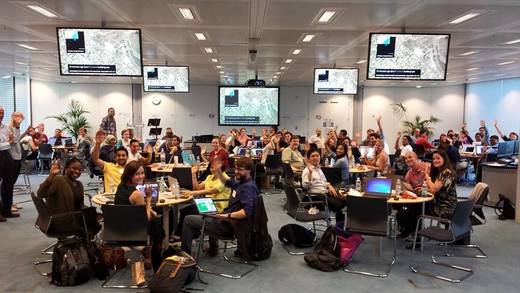
Second step … Planning the Mapathon
Now that you have enough information from your first steps to decide the numbers, location and available dates you can start planning your Mapathon.
- Set the date and time for the Mapathon in line with availability of venues (Be careful to check that it does not clash with some other major event that would affect you being able to attract volunteers and mappers to your event). Allow at least 2.5 to 3 hours minimum for your event (half an hour for speeches and training, half an hour for refreshments, two hours for mapping).
- Book the venue. Make sure the location of the venue is on Openstreetmap.
- Distribute invites to Mappers through local and online media to aim for good attendance. Eventbrite is a good way of booking places at the event.
- Will you be providing snacks/refreshments at the event? (Pizza has proved to be a popular choice but choose the popular foods for your part of the world).
- Set up a project for the event. Remember that your first Mapathon in your area will possibly comprise a large proportion of beginners. Suggest that you have two easy projects for beginners and two more challenging tasks for more experienced mappers. Contact the Missing Maps Project if you need help with setting up projects and also for Mapathon materials for the tables and direction signs for the corridors. The Tasking Manager is a good source of useful projects.
- Suggested helpers that you may need for the event
- An experienced mapper to talk them through the mapping process.
- An IT person from the venue to trouble shoot any connectivity problems.
- A guest speaker to talk about their experiences with Openstreetmap
- Ideally one experienced mapper per table to check that they know what to do and to answer any questions. Contact the Missing Maps Project to assist in finding helpers and also check for experienced mappers in your area
- A deputy to help with the arrangements and stand in for you as a back up.
- Add your event to the Mapathon calendar.
- Have someone available from the local media to take photos and report the event.
- Arrange for someone to film the presentation and create a live link for any remote mappers.
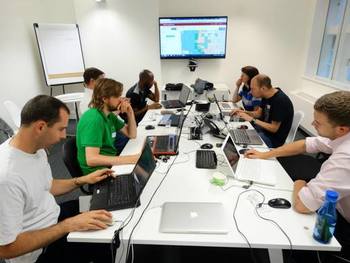
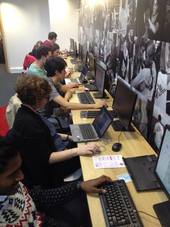
The week before the Mapathon
- Visit the venue and check that all the arrangements are still in place. (venue, helpers, equipment).
- Compile a list of attendees for messaging and for identity tags for the event.
- Send out message to attendees reminding them to bring laptop and mouse and have their Openstreetmap account set up, their log in details with them, and JOSM downloaded if that is their choice of editor.
- Post notices on line, with links to the ticket allocation, reminding attendees to take up the last remaining spaces at your event.
- Plan the layout for positioning of tables and chairs in respect to available power points and view of the large overhead screen.
- Check that you have current mapping projects for the event.
- Check that you have funding for the refreshments and any other costs.
- Arrange for Mapathon Materials (or create your own) to be printed off ready for the event.
- Check that someone will be bringing any equipment (extension cords, spare mouse) and table aids that will be needed.
- Notify your helpers that you need them to be at the venue half an hour before the start to help put out the tables, chairs, extension cords, etc.
- Check that there is a log in to the wi-fi at the venue and a password is available for all to use.
- Create a register that should be taken to every Mapathon to record attendees, their user names and the editor they use. This will give an ongoing record to assess how many mappers return for a second session or more, to assess which mappers continue to map during the period between events, to assess the success rate of retaining mappers and so on.
- Contact the remote validators at least two days before the event to instruct them on the projects being worked on and any other details to help them help the Mapathon.
- Decide on a local pub or other venue for the meet up afterwards and check that it is on Openstreetmap
At the Mapathon
- Arrive early at the venue to check that reception is all primed and prepared for the event.
- Walk round the venue to familiarise yourself with the area, toilets, emergency exits, etc.
- Brief the helpers as to the layout of the room and get your deputy to oversee them on setting out the tables, chairs and equipment, putting up direction signs in the corridors.
- Check with the resident IT person that the internet connections are all working and the overhead large screens are connected to the relevant laptops.
- Have one helper at the door to welcome the mappers, give them their name tags and tell them where to sit.
- Have helpers moving from table to table helping mappers to log on when they arrive.
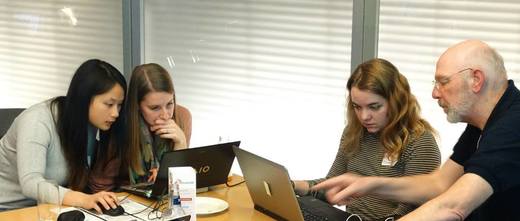
Start the Event
- Quieten everone down and start your welcome, introduction speech, programme for the event, fire evacuation instructions, position of toilets, etc.
- Introduce your experienced mapper and start the training process.
- During the event be ready to announce any helpful tips if it is noticed that a mistake is being made by some of the mappers (such as not squaring the buildings)
- https://osmlab.github.io/show-me-the-way/bbox.html is a nice way of putting something on the overhead screen for the mappers to see the live edits in progress.
- Check that the refreshments are in place for the mid-session break.
- Decide on a local pub for the meet up afterwards and check that it is on Openstreetmap.
- Check that the local media or/and a helper is taking photos.

At the end of the Event
- Thank the hosts for the great venue, the new mappers for coming along and joining the mapping community, the experienced mappers for their help and for their time and contributions, show them the progress that was made on the projects they worked on, ask them to come back to the next Mapathon and invite them to the pub afterwards.
- Check that the register of mappers has been completed
- Collect any equipment that was lent to mappers (mouse, laptop, etc.)
- Gather all the signs, equipment and collect any rubbish.
- Make sure the tables and chairs are put back and the venue is in a clean condition before leaving for the pub.
Not all work and no play
If your Mapathon becomes a regular event it is possible that you will start to get a core of regular attendees who will become your experienced helpers and help to make this a social event as well.
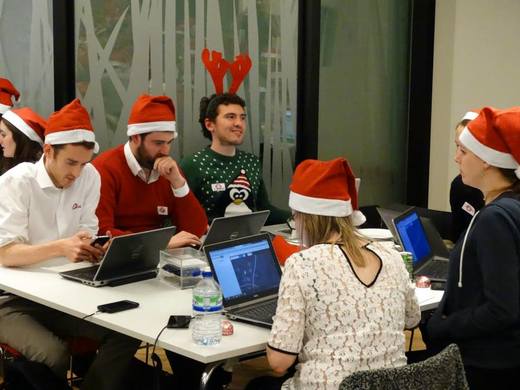
Other Resources
A checklist is available for download in both odt and pdf formats so that you can walk through it at preparatory meetings.
Useful resources for mapathons can also be found on our external resources page.








 Voltar ao início da página
Voltar ao início da página